Lowell Week in Review: June 19, 2016
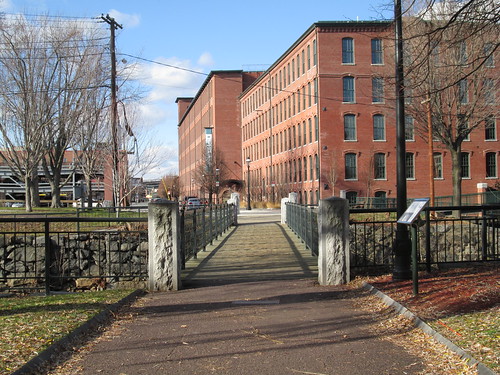
Perkins Place
Perkins Place
If you wanted to create a training film on how to best advocate your case before the city council, the remarks by residents of Perkins Place at last Tuesday’s council meeting would be a good starting point. Councilor Dan Rourke perhaps best illustrated how the residents’ oratory had changed minds when he said he had come into the meeting thinking “it’s a private sale; there’s nothing we can do,” but after hearing the residents’ pleas, he concluded “these people were screwed.”
And what were the pleas of those residents? Unanimously, they shared their enthusiasm for the lifestyle Perkins afforded them, specifically mentioning the proximity to downtown businesses and cultural attractions, its location along the Merrimack River, and a rare, pet-friendly policy. Several councilors said the residents who spoke were emblematic of “the type of people” they hope to have living in and around downtown (and by “type of people” I’m pretty sure they meant people with enough money to buy meals and drinks and tickets at downtown venues).
Legally, the tenants don’t have much recourse. The ability of a property owner to regain possession at the end of a lease has been a fundamental principle of property law for as long as there has been property law. Perhaps someone who moved in while the secret sales negotiations were on-going and specifically asked the landlord or its agent, “I’d like to live here long term; are there any plans to sell or convert to condominiums?” and was told unequivocally “no” might have a claim against the landlord under the state’s consumer protection act for unfair and deceptive practices, but that would just yield money damages, not continued possession of the apartment.
Nevertheless, it would make a lot of sense for the city and the University to create some kind of “relocation assistance task force” to help each tenant figure out a way to stay in Lowell. There may not be many apartments left in nearby Boott Mills, but more units are in the works. Renovations are underway at Massachusetts Mills off of Bridge Street and at the Appleton Mills on Jackson Street.
Then you have all the land in the Hamilton Canal District just waiting to be developed. HCD is supposed to be “mixed use” which would include housing. Winn Development – which has primarily done housing – was just selected as the developer of HCD. You could almost do a “build to suit” apartment complex in HCD for the Perkins Place tenants. Construction of such a building would certainly take more than a year, but that is where a sound relocation strategy involving the city, the University, and the tenants, could make a difference. Instead of being evicted after their current leases expire, maybe Perkins Place residents could be extended until their new quarters are ready for occupancy. Pulling off something like this would not be easy, but trying to do it would be more productive than just pointing fingers.
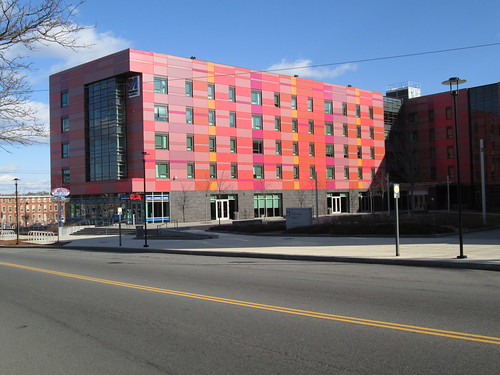
University Suites on Aiken St
University Expansion
Last Sunday I compared the anti-UMass Lowell sentiments now finding voice in Lowell to the negative attitude of residents of Lawrence that kept Emerson College from moving to that city back in the late 1980s. Hostility towards UMass Lowell was on clear display during Tuesday’s council meeting, but it wasn’t just about the Perkins Place deal. Some councilors seem opposed to any further expansion by UMass Lowell which left me wondering why they had remained silent all the times City Manager Kevin Murphy shared his vision that Lowell’s future lay in the city becoming a “college town.” Isn’t having the University own real estate inherent in making Lowell a college town? Last August, when word came that UMass Lowell was buying the Notini property on Aiken Street, I expressed skepticism that some who cheered the “college town” concept either didn’t understand it or didn’t believe in it. Nothing I saw at Tuesday’s city council meeting changed that opinion. You can’t encourage UMass Lowell to grow and then criticize it when it does.
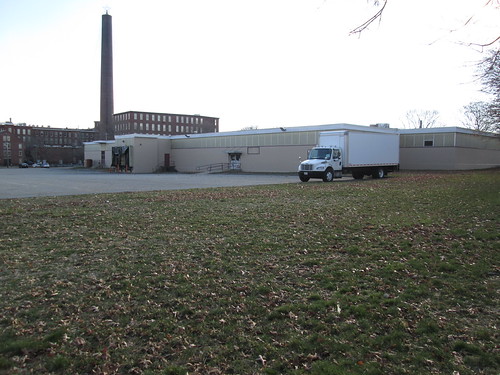
Notini property
As unfortunate as it may be in terms of displacing tenants, the University’s acquisition of the Perkins apartments and the earlier acquisition of the nearby Notini property make a lot of sense for the University and for the city. That entire area was once home to Little Canada, a densely-packed residential neighborhood, and to Merrimack Mills, a huge complex of brick mills and boarding houses that had fallen into disuse. With the city’s economy stagnating in the early 1960s, city leaders latched onto Federal Urban Renewal programs that offered millions of dollars to demolish such “slums” (an Urban Renewal term, not mine). The city’s plan was to replace the demolished housing and mills with “modern industry.” Well modern industry – whatever that might have been – followed workers to the suburbs and that entire Northern Canal Urban Renewal area, extending from the Howe Bridge to Lowell High School, has been underutilized for half a century.
Encouraging UMass Lowell to expand into that zone would benefit the University and the city. A fundamental challenge for UMass Lowell is having a noncontiguous campus, meaning the South Campus (former Lowell State Teachers College) and the North Campus (former Lowell Textile Institute) are physically separated by a half-mile of non-university property and both of those campuses are hemmed in by existing neighborhoods and the local geography. The newer East Campus has grown to include the Campus Recreation Center, five dormitories (Leitch, Donahue, Bourgeois, and Fox Halls plus University Suites), and University Crossing (formerly St. Joseph’s Hospital). At the far end of this East Campus is the Tsongas Center at UMass Lowell. If all goes right, a privately-owned dormitory by Vision will be just two blocks further down. That entire stretch of land between the Northern Canal and Merrimack River, could become part of the UMass Lowell campus with privately owned but compatible buildings like Wannalancit Mills and publicly owned places like LeLacheur Park and the Riverwalk intermixed. That would have the added benefit of drawing the land, building, employees, and students of the college to downtown Lowell and its stores, restaurants, and amenities. To me, that would be better use of that land than anything that has located there during the past fifty years. It would also advance the city manager’s vision of Lowell as a college town.
As for “lost property taxes,” it is true that the city cannot impose property taxes on real estate owned by the University but it’s misleading to call UMass Lowell “a nonprofit” which so many continue to do. Saying that UMass Lowell is a “nonprofit” implies that it’s some kind of charitable corporate entity. It’s not. It’s an arm of state government. Under our system of government, subordinate governmental entities do not pay taxes to superior governmental entities. The federal government is not taxed by the state and the state government is not taxed by municipalities. I suppose the members of our legislative delegation could file a bill seeking reimbursement to the city for property taxes lost by having the University located here, but their colleagues would laugh them out of their respective chambers since every rationally-thinking representative or senator would gladly trade whatever amount was lost in property taxes for all the benefits that would flow from having a major state university in one’s community.
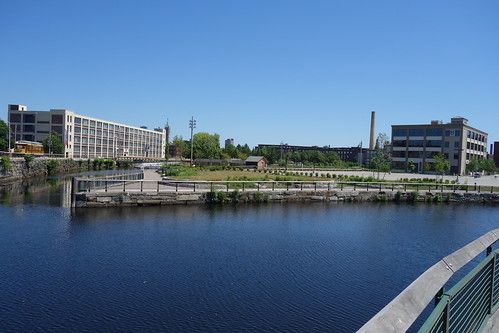
Hamilton Canal District
Hamilton Canal District
The 105 people who joined the Lowell Walk of the Hamilton Canal District yesterday were treated to an outstanding tour by Craig Thomas of the city’s Department of Planning and Development. In a way, this was Craig’s valedictory address to the community, for he will be leaving the employment of the city at the end of this coming week to become Director of Real Estate at Coalition for a Better Acre.
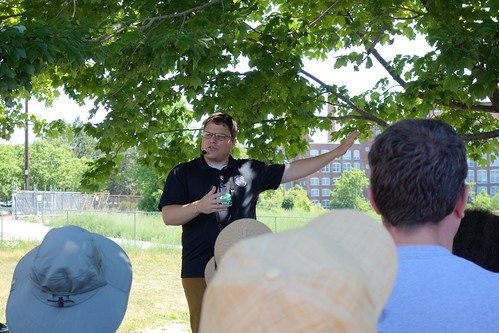
Craig Thomas
Craig offered much insight into the planning process for a development as large and complex as the Hamilton Canal District. He also made clear the importance of the infrastructure improvements like a bridge over the Pawtucket Canal that will connect Broadway to Jackson Street and other new roads within the HCD. Without these things, it is unlikely that private developers will move aggressively into the district. However, there were signs of progress. On the site where Watermark intends to build its corporate headquarters, disturbances in the grass that resembled freshly filled graves were evidence of soil borings that are part of the early design process. Across the extension of Jackson Street, small pink flags marked out the intended footprint of the Lowell Judicial Center which will tower over the neighborhood. Craig said the Commonwealth hopes to have the foundation of the Judicial Center in the ground by this November.
Finally, Craig explained that the entire rationale of the Hamilton Canal District was to extend downtown Lowell and its street patterns, building types, and day-to-day vibe, closer to the Gallagher Terminal. The HCD is not to be a suburban office park, nor is it to be a housing development. It’s supposed to be an urban, built up area, with a mixture of residences and businesses and a vibrant street life. That vision still applies today. It’s a big picture that’s important to keep in mind as the development progresses.
If UML feels hemmed in by existing neighborhoods how about the residents? UML expansion may be good for the city but it’s more than “unfortunate” for residents who lose their homes.